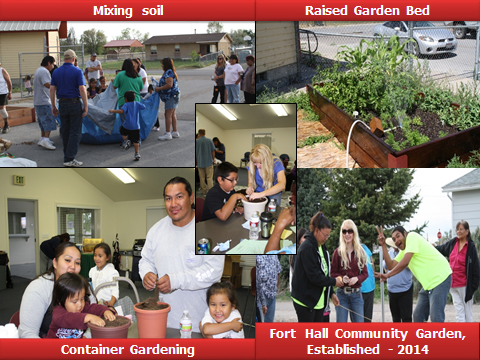
Danielle Gunn – Federally Recognized Tribes Extension Program (FRTEP) University of Idaho
The Shoshone-Bannock Tribes are located on the Fort Hall Reservation located in the eastern Snake River Plain of southeastern Idaho. The reservation occupies 545,662 acres, of which 344,942 acres consist of rangeland primarily used for cattle grazing, hunting and gathering; and approximately 150,000 acres are farmed. Cattle running on reservation rangeland number around 8,200 head. There are 69 tribal operations – 4 of which are owned and/or at least partially operated by women. The biggest economic challenges include weather-related issues, input costs – particularly winter feed costs and animal health issues. Nearly 25% of the roughly 3,500 people who reside on the reservation, live in poverty and have no high school diploma. The median income is $31,240 among Native Americans on the Fort Hall Reservation.

Program director and FRTEP agent Danielle Gunn, provides leadership and cultivates partnerships to develop and implement educational programs in response to producer, youth and community needs and requests. The
program’s results-based approach encourages community vitality and growth and fosters agricultural enterprise viability.
“[Community members] come to us for leadership and for assistance dealing with problems”
—Danielle Gunn
Impacts
FRTEP Fort Hall Extension is a trusted resource. When the program began Fort Hall Extension was underutilized. Community members have now come to rely upon its numerous programs and services which includes connecting tribal members to other agencies and resource partners.
 Agricultural practices have improved on the reservation through producers having increased knowledge, access and understanding of technologies which result in economic returns and financial stability. These factors improve ranch sustainability and quality of life. Research-based education and science-based programs delivered by the agent in concert with other Extension specialists, scientists and agencies enables producers to solve problems with proven tools in time to make a difference; i.e. addressing reproductive efficiencies for cattle, improving animal health programs, range health and noxious weed control. One rancher expanded his herd by 50% through applying reproductive technologies that improved heifer development. Other producers followed suit after witnessing his success. When the West Nile virus appeared in 2006, Extension was positioned and provided materials and education for the community to manage the disease. These and other educational endeavors have greatly improved producers’ knowledge and skill base and helped them manage their operations and problems more efficiently.
Agricultural practices have improved on the reservation through producers having increased knowledge, access and understanding of technologies which result in economic returns and financial stability. These factors improve ranch sustainability and quality of life. Research-based education and science-based programs delivered by the agent in concert with other Extension specialists, scientists and agencies enables producers to solve problems with proven tools in time to make a difference; i.e. addressing reproductive efficiencies for cattle, improving animal health programs, range health and noxious weed control. One rancher expanded his herd by 50% through applying reproductive technologies that improved heifer development. Other producers followed suit after witnessing his success. When the West Nile virus appeared in 2006, Extension was positioned and provided materials and education for the community to manage the disease. These and other educational endeavors have greatly improved producers’ knowledge and skill base and helped them manage their operations and problems more efficiently.
Relationship building between Extension and ranchers is key to addressing and solving a wide range of issues including large range fires, animal and range health. One producer asked for the agent’s help to determine what was killing cattle on one large reservation range unit. The agent worked with the USDA Poisonous Plant Laboratory in Logan, Utah to identify the cause of the cattle deaths. It was determined that woody aster was accumulating high amounts of selenium from an abandoned phosphate mine. Cattle were ingesting this plant which can result in selenosis and death. Affected producers volunteered to help the agent identify and treat woody aster infestations. They also contact the agent when dead cattle are found so she can perform necropsies to determine the cause of death. The monitoring and treatment of woody aster has resulted in zero cattle deaths related to selenosis for two years (2016-18).
“Availability of technology to tribal members through an unbiased source of research-based information is absolutely and extremely necessary.”
—Danielle Gunn

When asked what distinguishes the FRTEP Fort Hall Extension Program, the agent’s response was that it is a well-rounded program that addresses several priority areas as idenfied by producers, community members and tribal leaders. What contributes heavily to its success are the many demonstration projects initiated by the agent which demand a lot of field work – working with livestock, range fires, noxious weeds and poisonous plants. The tribe benefits greatly when the program operates out in the field, working with groups or one on one.
Extension is viewed as a valuable resource for tribal farms and ranches to help them become more sustainable and profitable. Related to this is the desire of the tribe to involve more youth in livestock production and to develop programs that will engage youth in agricultural-based venues.
FRTEP Fort Hall Extension will continue to provide leadership in response to community needs – to improve agriculture with education, science and technology; to improve the lives of youth, community members and producers through food preservation and nutrition skills –all of which enhance community growth and vitality.
